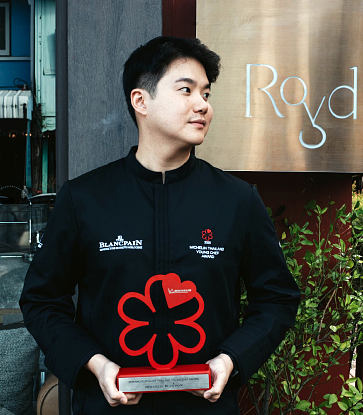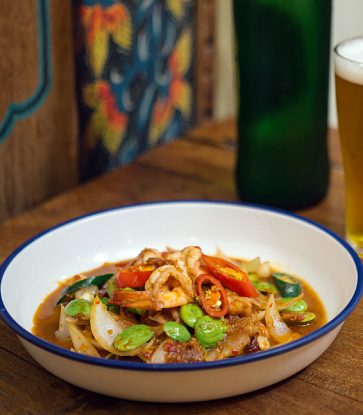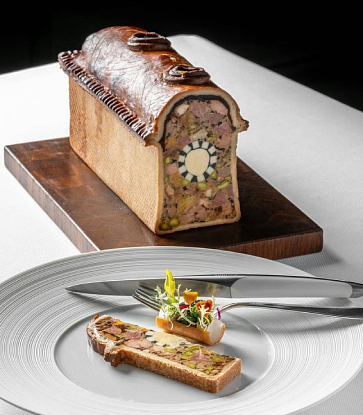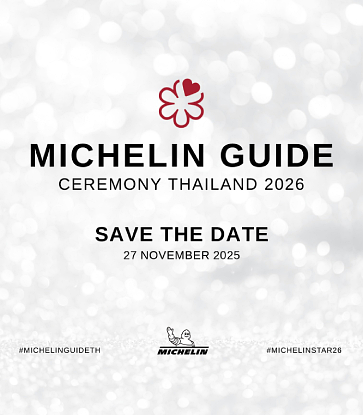Although Phad Thai seems to be Thailand’s most famous noodle dish, found in Thai restaurants all over the globe, the country actually has plenty of local variants when it comes to noodles. From Northern Thai Khao Soi with its crispy noodles to Khanom Chin with crab in the South, and Central Thai's hearty Boat Noodle, among others, there are a handful of people with fierce determination to elevate these local noodle specialties.
Chef Chudaree ‘Tam’ Debhakam, at the helm of Baan Tepa (One MICHELIN Star, MICHELIN Guide Thailand 2023), mentioned "Dong Dang", a Northeastern Thai rice noodle, during an interview at the 2023 MICHELIN Star Revelation Thailand event. She expressed that this Thai noodle dish is her signature and reflects her identity.
But what exactly is Dong Dang, and how does it symbolise Chef Debhakam? Let's delve into it.

Love at first bite
Chef Debhakam first discovered 'Dong Dang' in Udon Thani, a Northeastern Thai province, and immediately recognised the noodle's potential. “Dong Dang” is crafted from ingredients similar to rice noodles, but it features a wider and shorter shape. Freshly made Dong Dang noodles provide a delightful chewiness that enhances the overall flavour of the dish. This exceptional quality inspired Chef Debhakam to create her own version, which seamlessly complements the future menus at her restaurants. Depending on how she molds the dough, the texture of her Dong Dang can range from resembling Korean Tteokbokki to Italian thick pasta.Hawm Gra Dang Ngah Rice is selected as the key ingredient due to its distinctive smoky aroma. The chef was introduced to this product during a pop-up project before she established Baan Tepa.

Secrets to her signature dish
Flour from Hawm Gra Dang Ngah Rice is combined with rice and tapioca flour, along with salt and water. The rising star chef then employs a manual noodle press that she specifically designed for making Dong Dang. The dough is extruded into long slices through the press before being dropped directly into boiling water. The result is delightfully sticky noodles with just the right amount of chewiness.Chef Debhakam shares some tips for perfecting her Dong Dang. The first tip is not to overcook the noodles. The second is to ensure the texture reaches the desired level of stickiness. The final tip is to fry them at high heat to bring out their aroma. These three tips may not seem groundbreaking, but they represent the culmination of countless trials and errors in her experience.

From Dong Dang 1.0 to MICHELIN-Starred Noodle
Prior to the latest Black Squid Ink 'Dong Dang' now served at Baan Tepa, there were three previous versions. The first version featured Dong Dang noodles topped with chicken and truffle sauce. Dong Dang 2.0 was accompanied by Nam Ngiao (a Northern Thai curry). The third version was served with Xuanwei Ham dipping and miso ricotta.The third version is served with squid ink soup, a Southern Thai delicacy. The inspiration for this dish arose when the chef decided to create the soup, embarking on a journey to discover the finest ingredients. Dong Dang noodles became one of the discoveries along that culinary adventure.

Just like its Italian pasta counterpart, Dong Dang 4.0 boasts a rich infusion of squid ink. This exquisite dish is a harmonious blend of three distinct types of squid – the bigfin reef squid, octopus, and splendid squid – sourced fresh from Surat Thani and Koh Lanta of Thailand. Each squid variety undergoes its own unique preparation, with some being dry-aged and others sun-dried to perfection, before they're elegantly presented alongside a zesty lemongrass salad.
The dressing, a delectable combination of eastern-style salt and finely ground peppers, adds a burst of flavour that compliments the dish's seafood essence. Chef Debhakam's artistry is on full display as she delicately arranges the Dong Dang noodles atop this flavourful ensemble. The pièce de résistance, however, is the addition of the squid ink soup, which flawlessly completes the signature masterpiece of Baan Tepa.
Illustration image: © Anuwat Senivansa Na Ayudhya/ MICHELIN Guide Thailand




















